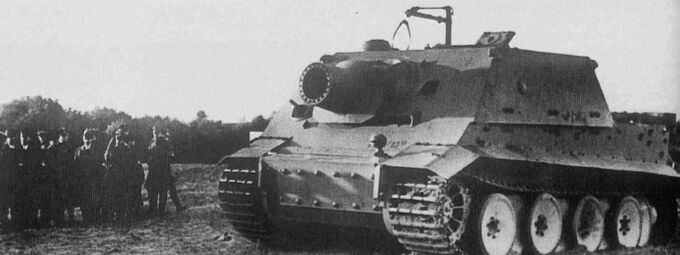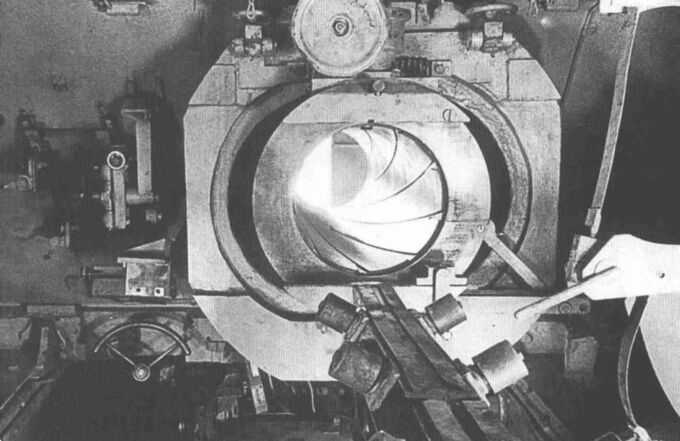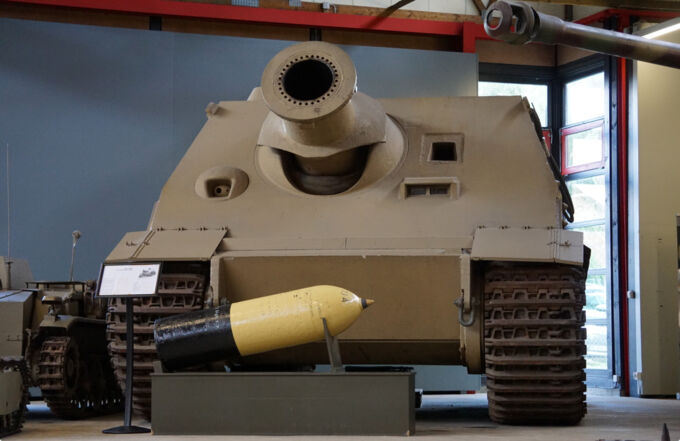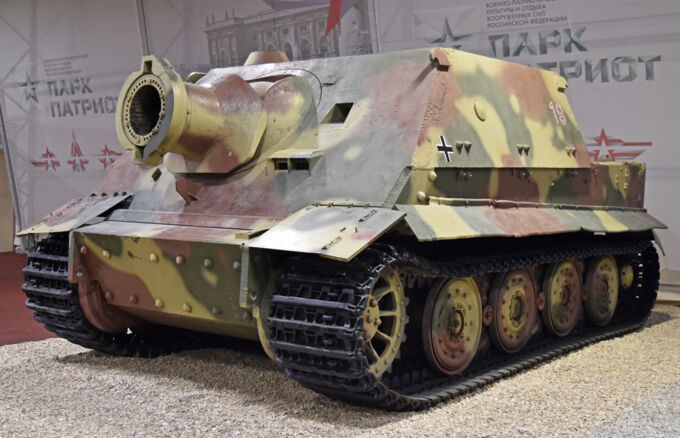The Sturmtiger (lit. 'Assault Tiger') was a heavy German self-propelled gun from World War II, developed on the basis of the Tiger I heavy tank. Its main armament consisted of the 38 cm RW61 rocket launcher. This rocket launcher was capable of firing massive explosive shells weighing 350 kg with a range of up to 5,000 meters. The Sturmtiger was primarily developed to destroy heavily fortified enemy positions, such as bunkers or occupied buildings. Its first battle was during the Warsaw Uprising in August 1944, where it successfully destroyed insurgent buildings and barricades. Other missions included the Battle of the Bulge, the Battle of the Reichswald (Kleve/Germany) and the Battle of Remagen. Due to its specific role and the limited production number of only 18 units, the Sturmtiger did not have a decisive influence on the course of the war.
Development
The idea of the assault tank for the Wehrmacht arose from the experience in the battle of Stalingrad, where house-to-house fighting was unavoidable in narrow alleys and streets where normal tanks were of little use, so the idea was born to build a tank that could destroy an entire house with one shot.
The Rocket Launcher RW 61
The RW 61 rocket launcher was originally developed and built for the Kriegsmarine by Rheinmetall and Borsig. It was originally designed as a depth charge launcher to combat submarines from the coast. To perform this duty, it fired its 38 cm rocket-propelled depth charge, which initially had a range of 3,000 meters.
After the development was completed, the idea arose to build a self-propelled gun with the weapon under the command of the navy. This led to a conflict between the army and the navy, as the army was of the opinion that there should be no land-based mobile artillery weapons under the command of the navy. The army then took the initiative and arranged for the construction of a tank with this weapon and the further development of the RW 61. The Raketenwerfer 61 was further developed into the 380 mm Raketenwerfer 61 L/5.4. The 38-cm rocket explosive grenade 4581 was also developed, which had an increased range of 5,000 — 6,000 meters. It weighed a total of 350 kg, of which 125 kg was explosive material and around 40 kg was solid fuel material for the rocket propulsion of the grenade, which accelerates it to 40 meters per second when it leaves the mortar muzzle and then further to 250 meters per second. Now the only question was about finding a suitable chassis for building the new self-propelled gun.
Since the Wehrmacht wanted to avoid building its own chassis and share existing spare parts, it opted for the Tiger I E chassis because these were currently available and could carry the weapon due to its weight. It also did not place too much strain on the Tiger I’s engine and still achieved a speed of 40 km/h. Only the springs and suspension had to be reinforced due to the additional weight of 65 tons. Inspector General Heinz Guderian then ordered the construction of a prototype for the army. Ongoing production could not be disrupted. Shortly thereafter, the Alkett works in Sömmedra and the Kirchmöser ironworks began building the Sturmtiger prototype, which had a body made of mild steel, while the Tiger I chassis already in service were refurbished and reused here.
On October 20, 1943, the prototype of the Sturmtiger was presented to Hitler at the Arys military training ground. It was not until April 19, 1944, that he ordered the production of 12 Sturmtigers with 300 rounds, as the Sturmtiger was gaining importance in Hitler’s mind at the time of the war. The production was spread over three months: August 1944 (3 vehicles), September 1944 (10 vehicles), and December 1944 (5 vehicles). Afterward, the production of the Sturmtiger in the Alkett factories, where a total of 18 Sturmtigers and 317 rounds were produced.
Mission
The 18 Sturmtigers were divided into three companies, known as “Assault Mortar Companies.” These were the 1000th, 1001st, and 1002nd Sturmtigers. Initially, each company consisted of two platoons of Sturmtigers (each platoon with two Sturmtigers), meaning four Sturmtigers per company. Later, they were reorganized into an artillery unit and renamed the “Sturm-Mörser-Batterie,” meaning each company now had three platoons, corresponding to six Sturmtigers per Sturmtigers battery. The Sturmtigers first saw combat during the Warsaw Uprising in 1944, when the 1000th Sturm-Mörser Company was deployed. At that time, it consisted of the Sturmtiger prototype and the first two production models, as no crews had yet been trained on the Sturmtiger. Mechanics and workers from the Alkett had to assume the role of crew. Shortly after the arrival of the three tanks, the prototype was sent back by train and received a steel armored casemate at the Alkett factory. After the brutal suppression of the uprising, the two production models were brought back to Germany.
Sturm-Mörser-Kompanie/Batterie 1000
Formed on August 13, 1944, and assigned to Army Group Center on August 14, 1944. Between August 15 and 18, a platoon of three Sturmtigers (the prototype and the first two production models) was dispatched to Warsaw to suppress the uprising there, alongside other SS and army units. While the two production models fought against the insurgents, the prototype was sent back shortly after their arrival and fitted with an armored steel casing at the Alkett factory. These units were still manned by workshop personnel. On August 25, 1944, one platoon reached Meaux, France; another was assigned to Panzerbrigade 109 in Hungary on September 10, 1944. On October 20, 1944, the company was transferred from Budapest to Warsaw, and from there on October 22, it was transferred to Sennelager (Paderborn) for retraining, arriving there on November 13. On December 15, the company participated in the “Wacht am Rhein” (Battle of the Bulge) and was initially subordinated to the 15th Army, later to the 6th Panzer Army in Elsdorf-Gmünd. However, the tanks arrived late in the staging areas and were therefore rarely or never used. On January 23, 1945, it was reorganized into an artillery battery with six Sturmtigers.
Sturm-Mörser-Kompanie/Batterie 1001
Formed on September 23, 1944. The individual platoons were ready for action on September 28 and October 5, 1944, and the company reported ready for action on October 22, 1944. From November 10, 1944, the unit was placed under the command of the Commander-in-Chief West and prepared for the Battle of the Bulge. The company was initially assigned to the 15th Army, later to the 6th Panzer Army. During the Battle of the Bulge, the vehicles were deployed in the Eifel near Düren and Euskirchen. After the Battle of the Bulge, the unit withdrew across the Rhine and took up positions between Bonn and Drolshagen. On January 23, 1945, it was reorganized into an artillery unit with six Sturmtigers. The last three Sturmtigers remaining after the fighting in the Ruhr were blown up and their crews captured by the Americans.
Sturm-Mörser-Kompanie/Batterie 1002
Formed on October 22, 1944, it was subordinated to the OB West from December 1944. Its first deployment was in the fighting in the area of the 1st Parachute Army from February 7 to 22, 1945, in the Kleve area on the Lower Rhine (Reichswald). Like the other two companies on January 23, 1945, it was reorganized into an artillery unit, which resulted in the addition of two additional Sturmtigers. After the fighting on the Lower Rhine was over, it was relocated to the eastern bank of the Rhine near Reinsberg. The battery was deployed near Dorsten, Kirchhellen (Recklinghausen district), and Datteln. Further retreats continued eastward via Marl to Minden. According to photographic evidence, one Sturmtiger was captured by the Americans near Ebendorf; it had previously been hidden in the shaft entrance of a coal mine and only emerged to fire. In March 1945, the last two Sturmtigers were blown up there, and the crews were taken prisoner by the Allies.
Technical Data
- Speed: Road: 40 km/h, Off-road: 24 km/h
- Fuel capacity: 534 l
- Range: 120 km on road, 85 km on medium terrain
- Armament: 38 cm RW61 L/5.4 (target: 3×8° anti-tank guns, ammunition: 14 rounds), 1×7.92 mm MG 34 in the hull (ammunition capacity: 800 rounds)
- Crew: 5 (commander, gunner, driver, loader, radio operator/machine gunner)
- Armor: 150 mm turret, 100-80 mm hull
Surviving Sturmtigers
Today, only two Sturmtigers remain, one in the German Panzer Museum in Munster and another one in the Kubinka Tank Museum in Russia. There is also an RW 61 rocket mortar in the Bovington Tank Museum.
Deutsches Panzer Museum Munster
The Sturmtiger from the German Panzer Museum in Münster has the chassis number 250174 and belonged to the Sturm-Mörser Company/Battery 1002. It was abandoned in April 1945 by its crew, who failed to destroy the Sturmtiger. For this reason, it was captured by the Allies and taken to America, where it was tested at the Aberdeen Proving Ground in Maryland. Later, it was brought back to Germany and delivered to the Bundeswehr 91 test site in Meppen. The Sturmtiger was then refurbished at the Army Repair Plant in St. Wendel in Saarland. After that, it was brought to the Wehrtechnische Studiensammlung in Koblenz in 1981, where it was exhibited until 1996. Until it was loaned to the Technology Museum in Sinsheim and then the Sturmtiger came to the German Tank Museum in 2003 and has been on display there ever since.
Tank Museum Kubinka
The Sturmtiger in the Kubinka Tank Museum has the chassis number 205543 and is said to have been captured by Soviet troops in the Elbe region in April 1945.
Bovington Tank Museum
The RW 61 in the Bovington Tank Museum came from a Sturmtiger which was brought to Great Britain at the end of the war, where it was tested and then scrapped, and only the RW 61 launcher was preserved and handed over to the Bovington Tank Museum.
- [Wiki DE] 38-cm-Sturmmörser
- [Wiki EN] Sturmtiger
- [Wiki VI] Sturmtiger
- [Wiki IT] Sturmtiger
- [Lexikon der Wehrmacht DE] Gliederungen der Sturmtigereinheiten
- [Wikibrief DE] Sturmtiger
- [Tankmuseum Bovington Articel] Sturmtigers Fire Power
- [Tankmuseum Bovington Articel] Vehicle-Sturmtiger
- [Das Panzermuseum] Documentary Series (DE) “Der Sturmtiger” Episode 1-7 (youtube)
- Deutsches Panzer Museum








